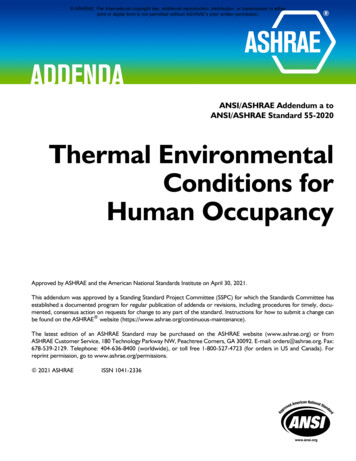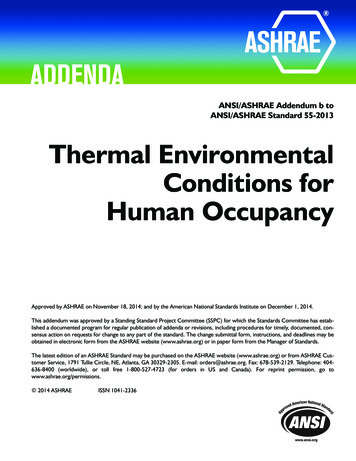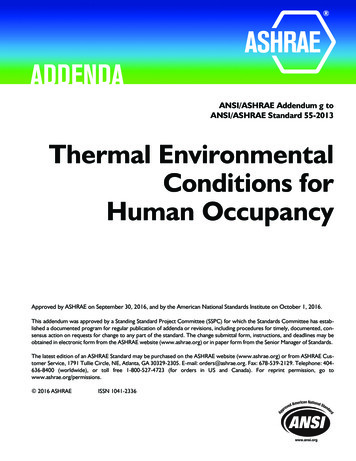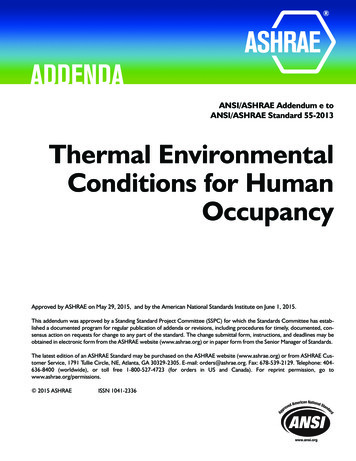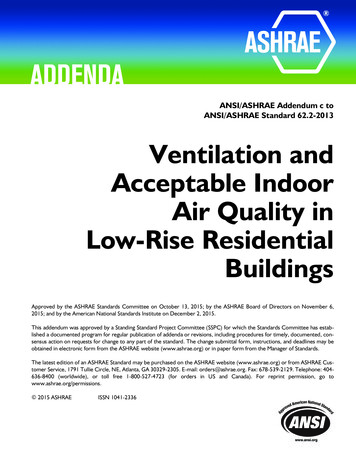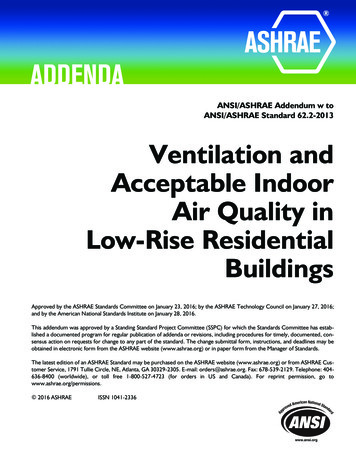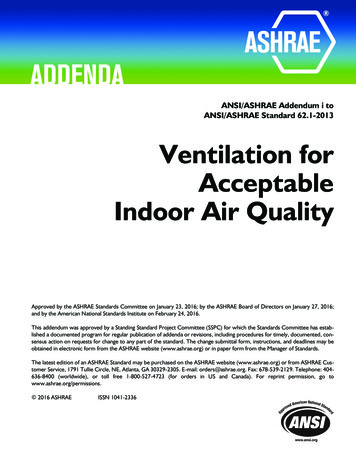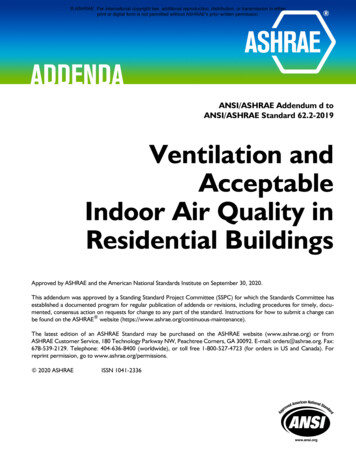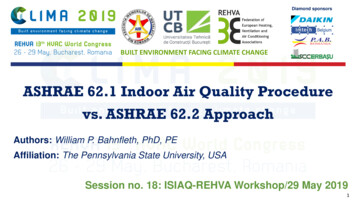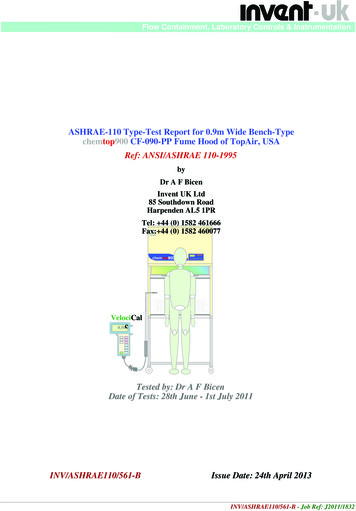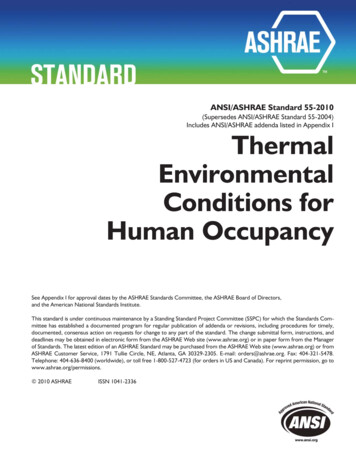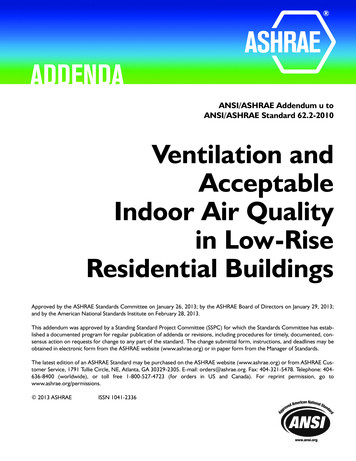
Transcription
ANSI/ASHRAE Addendum u toANSI/ASHRAE Standard 62.2-2010Ventilation andAcceptableIndoor Air Qualityin Low-RiseResidential BuildingsApproved by the ASHRAE Standards Committee on January 26, 2013; by the ASHRAE Board of Directors on January 29, 2013;and by the American National Standards Institute on February 28, 2013.This addendum was approved by a Standing Standard Project Committee (SSPC) for which the Standards Committee has established a documented program for regular publication of addenda or revisions, including procedures for timely, documented, consensus action on requests for change to any part of the standard. The change submittal form, instructions, and deadlines may beobtained in electronic form from the ASHRAE website (www.ashrae.org) or in paper form from the Manager of Standards.The latest edition of an ASHRAE Standard may be purchased on the ASHRAE website (www.ashrae.org) or from ASHRAE Customer Service, 1791 Tullie Circle, NE, Atlanta, GA 30329-2305. E-mail: orders@ashrae.org. Fax: 404-321-5478. Telephone: 404636-8400 (worldwide), or toll free 1-800-527-4723 (for orders in US and Canada). For reprint permission, go towww.ashrae.org/permissions. 2013 ASHRAEISSN 1041-2336
ASHRAE (www.ashrae.org). For personal use only. Additional reproduction, distribution, ortransmission in either print or digital form is not permitted without ASHRAE's prior written permission.ASHRAE Standing Standard Project Committee 62.2Cognizant TC: TC 4.3, Ventilation Requirements and InfiltrationSPLS Liaison: Steven J. EmmerichDon T. Stevens, Chair*Paul Francisco, Vice-Chair*David A. Baylon*Terry M. Brennan*Gary CrawRoy R. Crawford*David C. Delaquila*Lance L. DeLauraS. Craig DrumhellerPhilip W. Fairey, III*Dwight H. Heberer*Mark C. Jackson*David E. JacobsRichard John Karg*Glenn P. LanganMichael R. Lubliner*Jane MaloneStephany I. Mason*James C. Moore*Amy B. Musser*Paul H. Raymer*Armin Rudd*Kenneth Sagan*Max H. ShermanSarany SingerThomas R. StroudZuraimi M. Sultan*Christine Q. SunDon Surrena*Iain S. Walker*Eric D. Werling*Bruce A. Wilcox*Ted A. Williams**Denotes members of voting status when the document was approved for publicationASHRAE STANDARDS COMMITTEE 2012–2013Kenneth W. Cooper, ChairWilliam F. Walter, Vice-ChairDouglass S. AbramsonKarim AmraneCharles S. BarnabyHoy R. Bohanon, Jr.Steven F. BruningDavid R. ConoverSteven J. EmmerichJulie M. FergusonKrishnan GowriCecily M. GrzywaczRichard L. HallRita M. HarroldAdam W. HingeDebra H. KennoyJay A. KohlerRick A. LarsonMark P. ModeraStephanie C. Reiniche, Manager of StandardsJanice C. PetersonHeather L. PlattIra G. PostonDouglas T. ReindlJames R. TaubyJames K. VallortCraig P. WrayCharles H. Culp, III, BOD ExOConstantinos A. Balaras, COSPECIAL NOTEThis American National Standard (ANS) is a national voluntary consensus standard developed under the auspices of ASHRAE.Consensus is defined by the American National Standards Institute (ANSI), of which ASHRAE is a member and which has approved thisstandard as an ANS, as “substantial agreement reached by directly and materially affected interest categories. This signifies the concurrenceof more than a simple majority, but not necessarily unanimity. Consensus requires that all views and objections be considered, and that aneffort be made toward their resolution.” Compliance with this standard is voluntary until and unless a legal jurisdiction makes compliancemandatory through legislation.ASHRAE obtains consensus through participation of its national and international members, associated societies, and public review.ASHRAE Standards are prepared by a Project Committee appointed specifically for the purpose of writing the Standard. The ProjectCommittee Chair and Vice-Chair must be members of ASHRAE; while other committee members may or may not be ASHRAE members, allmust be technically qualified in the subject area of the Standard. Every effort is made to balance the concerned interests on all ProjectCommittees.The Manager of Standards of ASHRAE should be contacted for:a. interpretation of the contents of this Standard,b. participation in the next review of the Standard,c. offering constructive criticism for improving the Standard, ord. permission to reprint portions of the Standard.DISCLAIMERASHRAE uses its best efforts to promulgate Standards and Guidelines for the benefit of the public in light of available information andaccepted industry practices. However, ASHRAE does not guarantee, certify, or assure the safety or performance of any products, components,or systems tested, installed, or operated in accordance with ASHRAE’s Standards or Guidelines or that any tests conducted under itsStandards or Guidelines will be nonhazardous or free from risk.ASHRAE INDUSTRIAL ADVERTISING POLICY ON STANDARDSASHRAE Standards and Guidelines are established to assist industry and the public by offering a uniform method of testing for ratingpurposes, by suggesting safe practices in designing and installing equipment, by providing proper definitions of this equipment, and by providingother information that may serve to guide the industry. The creation of ASHRAE Standards and Guidelines is determined by the need for them,and conformance to them is completely voluntary.In referring to this Standard or Guideline and in marking of equipment and in advertising, no claim shall be made, either stated or implied,that the product has been approved by ASHRAE.ASHRAE is a registered trademark of the American Society of Heating, Refrigerating and Air-Conditioning Engineers, Inc.ANSI is a registered trademark of the American National Standards Institute.
ASHRAE (www.ashrae.org). For personal use only. Additional reproduction, distribution, ortransmission in either print or digital form is not permitted without ASHRAE's prior written permission.(This foreword is not part of this standard. It is merelyinformative and does not contain requirements necessaryfor conformance to the standard. It has not beenprocessed according to the ANSI requirements for astandard and may contain material that has not beensubject to public review or a consensus process.Unresolved objectors on informative material are notoffered the right to appeal at ASHRAE or ANSI.)FOREWORDThis addendum simplifies compliance with the intermittent ventilation requirements of Section 4.5 if the duty cycleis three hours or less. Under the previous wording, designersof intermittent systems had to calculate a ventilation effectiveness factor even if operating the system 90% of the timewith a duty cycle of one hour. This addendum returns to thethree hour maximum duty cycle that was in the 2004 and2007 editions of Standard 62.2 before the ventilation effectiveness factor must be reduced below 1.0. This will simplifycompliance for 80% of the users of 62.2. It also addressesthe use of two or more fans to provide the required ventilation rate.Note: In this addendum, changes to the current standardare indicated in the text by underlining (for additions) andstrikethrough (for deletions) unless the instructions specifically mention some other means of indicating the changes.Addendum u to Standard 62.2-2010Add the following new definition to Section 3.3. DEFINITIONStime average airflow rate: the total volume of air providedduring a period of time divided by the time period.Modify Section 4 as shown. Note that these changes includethose in published Addenda i and n to Standard 62.2-2010currently available for free on the ASHRAE website andards-addenda. There are no changes to the remainder ofSection 4.4.1 Ventilation Rate. A mechanical exhaust system, supplysystem, or combination thereof shall be installed for eachdwelling unit to provide continuous whole-building ventilation with outdoor air each hour at a rate not less specified inSection 4.1.1, Fan Ventilation Rate Method, or Section 4.1.2,Total Ventilation Rate Method.Exception: An intermittently operating whole-buildingmechanical ventilation system shall be permitted if theventilation rate complies with Section 4.5. The systemshall be designed for automatic operation.4.2 System Type. The whole-housebuilding mechanicalventilation system shall consist of one or more supply orexhaust fans and associated ducts and controls. Local exhaustfans shall be permitted to be part of a mechanical exhaustsystem. Outdoor air ducts connected to the return side of an airhandler shall be permitted as supply ventilation if manufacANSI/ASHRAE Addendum u to ANSI/ASHRAE Standard 62.2-2010turers’ requirements for return air temperature are met. SeeChapter 10 of Guideline 242 for guidance on selection of methods.4.4 Control and Operation. The “fan on” switch on a heating or air-conditioning system shall be permitted as an operational control for systems introducing ventilation air througha duct to the return side of an HVAC system. Readily accessible override control must be provided to the occupant. Localexhaust fan switches and “fan on” switches shall be permittedas override controls. Controls, including the “fan-on” switchof a conditioning system, must be appropriately labeled.Exception: An intermittently operating, whole-housemechanical ventilation system may be used if the ventilation rate is adjusted, according to the exception to Section 4.5. The system must be designed so that it canoperate automatically based on a timer. The intermittentmechanical ventilation system must operate at least onceper day and must operate at least 10% of the time.4.5 Intermittent Ventilation. Whole-building mechanicalsystems designed to provide intermittent ventilation shallcomply with this section.4.5.1 Intermittent Delivered Ventilation Rate. Whenmechanical ventilation is provided at least once every 3 hoursby a system of one or more fans, Tthe delivered intermittentmechanical ventilation rate shall be calculated as the larger ofthe time-average total supply or average total exhaust airflowrate during each hour of operation, and shall be no less thanspecified in Section 4.1.4.5.1 4.5.2 Extended Cycle Intermittent Ventilation. Whenthe required average mechanical ventilation rate is notsupplied during every hour of operation, the delivered ventilation is deemed sufficient when the effective mechanicalventilation rate complies with this section. The effectivemechanical ventilation rate of an extended cycle intermittentsystem is the combination of the fan-flow rate during the oncycle, the fractional on-time, the cycle time, and the mechanical ventilation effectiveness as defined below. The fan flowrate required to achieve an effective mechanical ventilationrate that is equivalent to the continuous mechanical ventilationrequirement is based on the principle of equivalent dose andshall be calculated from the following: When mechanicalventilation is not provided at least once every 3 hours by asingle fan system, the intermittent fan airflow rate (Qon) shallbe calculated from Equation 4.8. Fan cycle time (Tcyc) shallnot exceed 24 hours. Where the fan airflow rate during the oncycle varies with time, the time average airflow rate duringeach hour shall meet or exceed the intermittent mechanicalventilation requirement of Equation 4.8.Qon Qfan/( f)whereQonQfan (4.8)intermittent fan airflow rate during the ent (from Table 4.1a or 4.1b orEquation 4.1a or 4.1b)mechanical ventilation effectiveness (fromTable 4.2)1
ASHRAE (www.ashrae.org). For personal use only. Additional reproduction, distribution, ortransmission in either print or digital form is not permitted without ASHRAE's prior written permission.f fractional on time, defined as the on-time forone cycle divided by the cycle timeTable 4.2 also requires the calculation of the requiredturnover, N, as follows:N 12.8 Qfan Tcyc/AfloorwhereQfan Tcyc Afloor I-Pmechanical ventilation air requirement (fromTable 4.1a or Equation 4.1a), cfmfan cycle time, defined as the total time for oneoff-cycle and one on-cycle, hfloor area, ft2N 2.51 Qfan Tcyc/AfloorwhereQfan SI(4.9b)mechanical ventilation air requirement (fromTable 4.1b or Equation 4.1b), L/sTABLE 4.22(4.9a)Tcyc fan cycle time, defined as the total time for oneoff-cycle and one on-cycle, hAfloor floor area, m2The maximum allowable cycle time is 24 hours.For values not listed, use the next higher value for N or thenext lower value for f. Linear interpolation is allowedshall bepermitted.Switching between periods of intermittent mechanicalventilation and continuous or different periods of intermittentmechanical ventilation is acceptable. Cycle times and fractional on-times can vary from one intermittent cycle to the nextas long as each cycle consists of an off-period followed by anon-period with a ventilation rate that meets the above criteria.If the fan flow rate during the on-cycle varies with time, theaverage rate during each hour must meet or exceed the intermittent mechanical ventilation requirement of Equation 4.9.Mechanical Ventilation Effectiveness (ε) for Intermittent FansTurnover, 22040100 1.001.001.001.001.001.001.00ANSI/ASHRAE Addendum u to ANSI/ASHRAE Stan
2 ANSI/ASHRAE Addendum u to ANSI/ASHRAE Standard 62.2-2010 f fractional on time, defined as the on-time for one cycle divided by the cycle time Table 4.2 also requires the calculation of the required turnover, N, as follows: N 12.8 † Q fan T cyc/A floor I-P (4.9a) where Q fan mechanical ventilation air requirement (from Table 4.1a or Equation 4.1a), cfm T cyc fan cycle time .

